As civil society organizations and social movements working to find constructive solutions to climate change, we want to express our deep concerns with the upcoming privately organized meeting on geoengineering in Asilomar, California. Its stated aim, which is to «develop a set of voluntary guidelines, or best practices, for the least harmful and lowest risk conduct of research and testing of proposed climate intervention and geoengineering technologies,» is moving us down the wrong road too soon and without any speed limit.
Briefings

RE: Asilomar International Conference on Climate Intervention Technologies: March 22-26 2010

On the eve of a major intergovernmental conference on Agricultural Biotechnologies in Developing Countries (ABDC) in Guadalajara, Mexico, a civil society member of the international steering committee has resigned, calling the preparations for the gathering of governments and scientists “hopelessly biased” and “foolishly sidestepping key socioeconomic and scientific issues.”
Pat Mooney, Executive Director of ETC Group, a Canada-based international civil society organization with a long history of work with FAO and biotechnology issues, resigned from the steering committee on Tuesday, February 23 2010. The UN Food and Agriculture Organization conference, hosted by Mexico, runs from March 1- 4 in Guadalajara.

Climate Chaos in a Geoengineering Age, a Report Commissioned and Published by the Swedish Society for Nature Conservation.
This critical overview of geoengineering technologies examines the history, politics and social and ecological implications of attempts to add large-scale, intentional manipulation of the planet to the menu of possible responses to climate change. The report contests the notion that more funding, research and experimentation is needed into geoengineering technologies, and provides a series of recommendations on how these controversial technologies should be regulated.
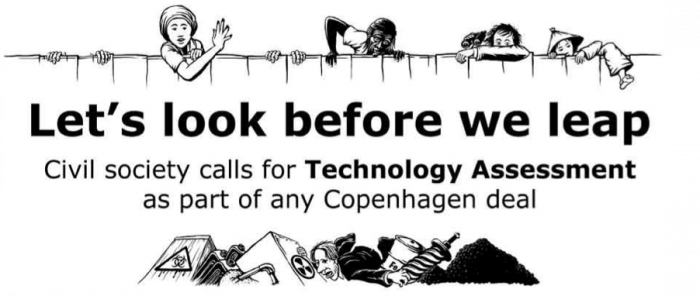
LA SOCIETÀ CIVILE CHIEDE VALUTAZIONE DEGLI IMPATTI DELLE TECNOLOGIE NELL'AMBITO DI UN ACCORDO A COPENHAGEN
l trasferimento di tecnologia è uno dei quattro temi principali che
verranno discussi nel corso dei negoziati sulle azioni di cooperazione
per il lungo termine a Copenaghen (gli altri sono mitigazione,
adattamento e finanziamenti). Il testo negoziale preliminare contiene
diverse misure volte ad accelerare la diffusione di nuove tecnologie.
Con ogni probabilità i negoziati si tradurranno in un "piano d'azione"
e in un nuovo "organismo" di gestione delle tecnologie, che dovrà
coordinare diversi pannelli tecnici e/o centri di innovazione, e che
avrà grande influenza negli anni a venire sul tipo di sostegno
politico e finanziario che le nuove tecnologie riceveranno. In questo
quadro, è di grande importanza riuscire a fare in modo che siano le
tecnologie appropriate e benefiche a ricevere il necessario sostegno,
e non quelle pericolose o dannose. Questo non può avvenire senza una
valutazione approfondita ed adeguata degli impatti ambientali e
sociali di ogni nuova tecnologia.
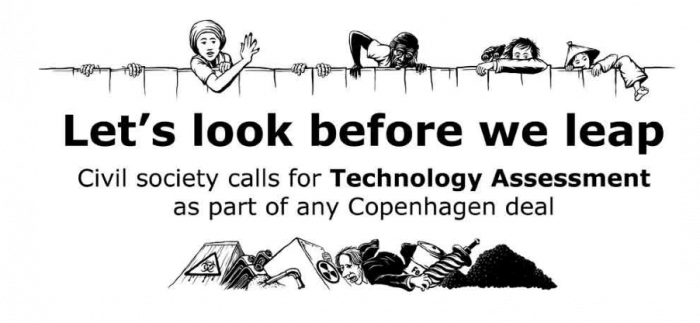
让我们三思而行 公民社会呼吁技术评估成为 任何哥本哈根协定的组成部分
我们 - 来自世界各地的公民社会组织和社会活动团体 – 认为迫切需要真正
的、持久的应对气候变化的解决方案。我们认识到,如果没有真正的、持久的应
对气候变化的解决方案,将带来人类不得不面对的致命后果。我们必须紧迫地增
强应对气候变化挑战的能力,同时显著减少温室气体的排放。
一些公司、个人、甚至是政府正在恐慌和无助地推广未经测试和未经证明的技术,
作为“我们唯一的选择”。然而我们不愿意看到,在没有考证对生态和社会影响
的情形下,这些未经测试和未经证明的技术,就被推广使用。一些视为能储存碳
或调控自然体系的技术,可能造成灾难性的生态和社会后果。在某些情形或方面
技术转让是在哥本哈根长期合作行动谈判中的四个关键议题之一 (其它是减
缓、适应和资金)。在讨论中的政府间谈判文本考虑了不同的加快技术渗透的
措施。它很可能是创建一个“行动计划”以及一个“技术机构”和不同的技
术组或创新中心,在以后的时间内证实它对决定何种技术获得资金及政治上
的支持具影响力。我们需要保证恰当的技术可以得到它们需要的支持,而错
误的技术会被放弃。如果没有一个全面的社会和环境的评估过程,这个目标
就不会实现。
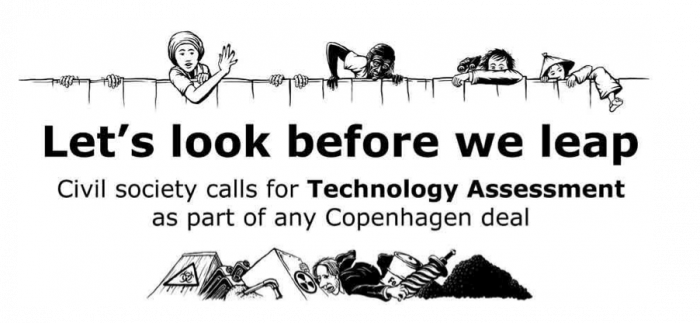
Technology transfer is one of the four key topics being discussed under negotiations on Long-Term Cooperative Actions in Copenhagen (the others are mitigation, adaptation and financing). The inter-governmental negotiating text that is under discussion contemplates various measures for accelerating the diffusion of technologies.

Rome’s Food Summit may determine who decides who will eat
The declaration coming out of the World Food Summit for Food Security in Rome is even worse than the “shameful” document adopted by world leaders in 1996, so famously criticized by Cuba’s Fidel Castro. Governments won’t promise anything to anybody. The only issue really being debated in Rome is whether control of the UN’s “Department of Agriculture” will be wrested from the UN’s Rome-based agencies and surrendered to an amorphous, G8 conjured, public-private compact called the Global Partnership for Agriculture, Food Security and Nutrition. If the Partnership prevails, national sovereignty fails, and civil society's hopes for Food Sovereignty will suffer.
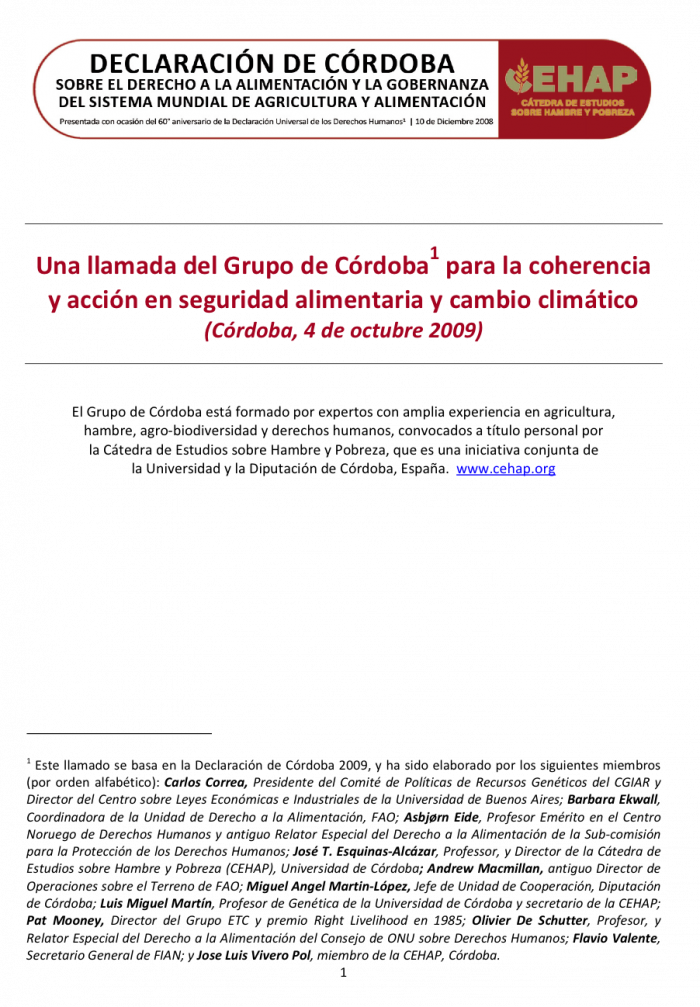
At the beginning of October 2009, the Córdoba Group -- a small gathering of independent food and agrocultural specialists (including the first and current UN Special Rapporteurs on the Right to Food) that have been meeting over the past two years -- published a brief (two-page) analysis of the state of global governance around food and agriculture and of the need to place the Right to Food and the interests of peasant producers at the center of the food and climate debate. The Group’s report was widely distributed at the UN Committee on World Food Security that met in mid-October and is influencing deliberations around both the World Food Summit in November and the December Conference in Copenhagen on Climate Change.
The Cordoba Group is formed by senior experts on hunger, agriculture, agrobiodiversity and human rights, convened in his/her personal capacities by the Chair of Hunger and Poverty Studies, a joint initiative by the University and the Diputacion of Cordoba, Spain.

Questions for the Food and Climate Crises
By 2050, or much sooner, we will be growing food under climatic conditions we’ve never seen before and learning that “normal” weather is an illusive fiction. Yet, we are told that global land grabs and plantations of agrofuels are a “win-win.” The truth is that policymakers don’t know enough about our food supply. We don’t know where our food comes from and we don’t know who is feeding the hungry today. We have absolutely no idea who will feed us in 2050. This report raises more questions than answers. It begins with a comparison of the likelihood of the industrial food chain and the peasant food web getting us through climate chaos.
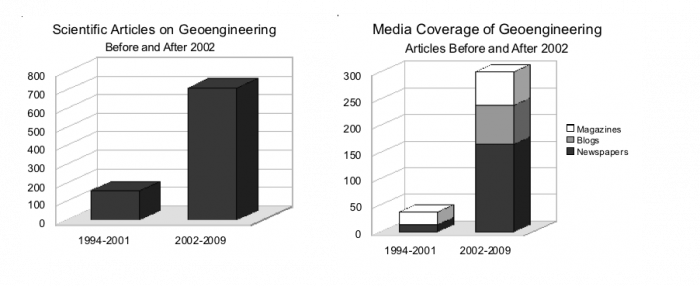
Geoengineering as 21st century fairytale
The idea of re-engineering the entire planet (geoengineering) used to be the stuff of science fiction, but in the past few years a small group of geoengineering enthusiasts has worked hard to give it a veneer of respectability. On 1st September, they will have succeeded in getting the world’s oldest scientific academy, the UK’s Royal Society, to legitimize dangerous planet-tinkering schemes with minimal transparency and even less public participation.
